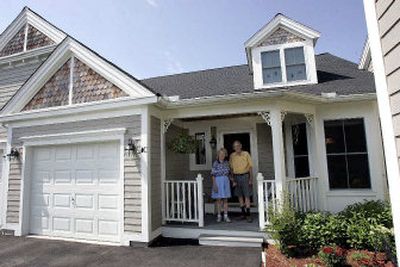Home stretch

HUDSON, Mass. — The condominium that retirees Richard and Mary Jean Ebens bought three years ago for $305,000 has some nice amenities: 2,000 square feet of living space, a garage, a basement, a deck looking over the garden, and a reasonable 45-minute drive to Boston.
But the social benefits are what make it special to Richard, 75, a former Episcopal pastor, and Mary Jean, the 69-year-old former operations manager for a computer company. That’s because The Villages at Quail Run, the 150-unit “active adult community” the Ebenses call home, is only for people 55 and older.
Age-restricted developments — which typically lack the medical care and services available in nursing homes and assisted living facilities — expanded in the 1990s in Sun Belt retirement havens after Congress granted developers exemptions from federal housing anti-discrimination statutes.
Thanks to accommodating local zoning rules and officials’ desire to attract older residents who aren’t a drain on the tax base, the projects are becoming increasingly common outside the Sun Belt, particularly in expensive housing markets in the Northeast. But some housing advocates claim it’s edging young families and others out of the housing market.
“Now you’re seeing a boom going on all around the country,” said Jeff Jenkins, assistant director of 50-plus housing for the National Association of Home Builders. About 60 percent of such developments are now outside the Sun Belt, with the growth in northerly states driven in part by many buyers’ wishes to stay closer to family and the communities where they spent their working lives, he said.
The number of projects has grown over the past decade to about 1,250 in 44 states, according to a private database, the National Directory of Lifestyle Communities. Developers are responding to the aging of the 78 million baby boomers born from 1946 to 1964. Active adult housing accounted for one-third of the 38,612 homes built across the nation last year by Pulte Homes, compared with one-quarter of its home production in 2001.
“We don’t see any end to the active adult boom in sight,” said Richard Dugas, chief executive of Bloomfield Hills, Mich.-based Pulte, the nation’s largest builder of active adult housing.
But some affordable-housing advocates in high-cost areas question whether age-restricted housing is growing too fast to meet market demand and taking up too great a share of new construction.
Although Richard Ebens embraces the trend, he worries the glut of adult communities will force out young families struggling to buy into a market where the construction is limited by strict zoning and shrinking tracts of available land. In Hudson, a bedroom community of 18,000 west of Boston, 474 of the town’s roughly 7,000 housing units are in age-restricted complexes.
“We are an aging population, so these projects serve a need,” Ebens said. “(But) I frankly don’t understand how young families can afford a house these days.”
Local governments are eager to sign off on housing for those at or near retirement, a sought-after demographic because they don’t come with school-age children and the related drain on tax dollars.
“We’re getting blocked out of the marketplace for non-age-restricted housing,” said Jeff Rhuda of Symes Associates Inc., a Beverly, Mass., developer of more traditional housing projects.
“While they’ve been choking down on regulations for building single-family homes, they’ve been changing zoning to create incentives for age-restricted housing.”
Seventy Massachusetts communities, for example, have zoning provisions to encourage age-restricted developments, according to a report from the Citizens Housing and Planning Association, a Boston-based nonprofit. Many have granted special permits for such housing that would not otherwise be allowed because of their locations or density.
“The problem is we need families and kids to keep the state competitive,” said Clark Ziegler, executive director of the Massachusetts Housing Partnership, a state agency that promotes affordable housing. “If we’re just building age-restricted housing, we’ll still have an affordability problem for people in the marketplace.”